| Overview |
All new Omnify objects are created/initiated using the New Object Wizard.
Most objects are placed under signoff, and are considered "pending" (internal state) until all required users on the signoff list have approved the object.
Once all users have approved, it is then available to be "released".
Administrators can define "default" and "required" fields for objects.
Fields can represent general fields, attributes, documents, vendors, etc.
"Default" and "required" fields will appear in the New Object Wizard for the user to supply values before creating the objects.
|
 |
Launching the New Object Wizard |
Top |
|
You can launch the New Object Wizard from the Common Links section of the Object Viewer.
Clicking the link will launch the New Object Wizard.

The New Object Wizard form will appear and the user will have to select the specific object from the drop list.
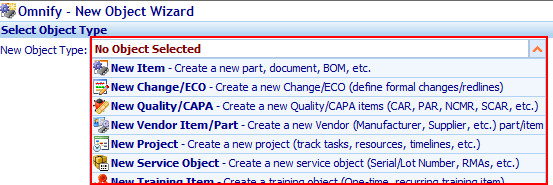
Placing the mouse over the hyperlink will present a popup menu that will allow you to select a specific type of object to create.
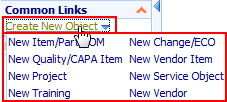
Selecting a specific object will launch the New Object Wizard form and automatically select the object.
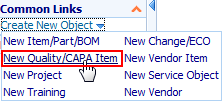
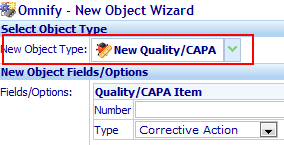
|
 |
New Object Wizard Form |
Top |
|
The New Object Wizard contains 2 main areas:

The Object Selection area is where the user will select the object type.

Once the object type has been selected, the Object Fields/Values area will update to display the available fields for the selected object.

Once all fields have been set, click the Create button to initiate the creation process.

|
 |
Object Type |
Top |
|
The Object Selection area will list all objects that the user can create based on their permissions.

To select an object, click the drop down button to display the available list.

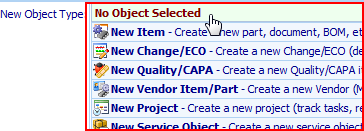
Once the object is selected, the list will condense again.


After selecting the object type, the Object Fields/Values area will update to display the available fields for the selected object.


|
 |
Object Fields |
Top |
|
After selecting the object type, the Object Fields/Values area will update to display the available fields for the selected object.


Omnify administrators can define "default" and "required" fields for objects.
The "default" and "required" fields will appear in the Object Fields/Values area.

In the example above, the administrator has defined the Build/Buy attribute to be a "default" field for all item types.
When the user selects the Item object, the Build/Buy attribute automatically appears in the General/Attributes Fields section.
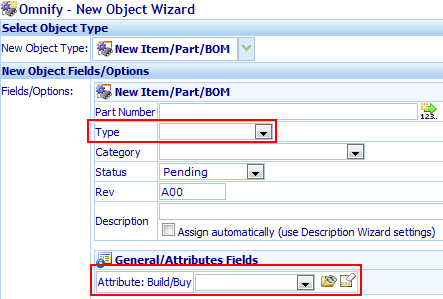
Administrators can also define "Type" and "Category" based default and required fields.

In the example above, the administrator has defined the Project, Business Unit, and Build/Buy attribute to be a "default" field for items of type "Assembly".

Fields can represent general fields, attributes, documents, vendors, etc.
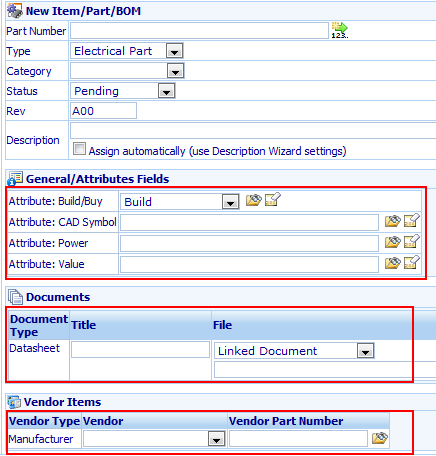
Based on the field type (pick list, multiple values, user text) the user will be able to either select, browse, or type a value.
You can use the Browse icon to select values from the database.
|
 |
Required Fields |
Top |
|
Omnify administrators can define "default" and "required" fields for objects.
Required fields will be indicated with a different color in the New Object wizard.
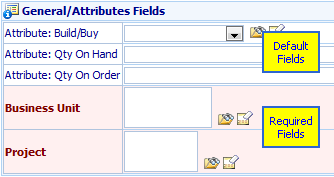
You will need to provide values for all Required fields before the system will allow you to create the object.
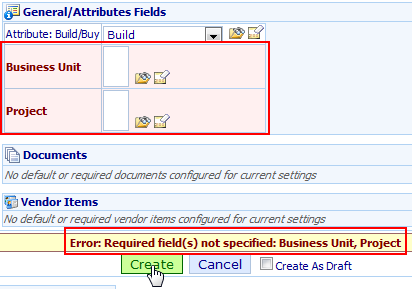
Note: the administrator can enable an option to ignore required fields when creating "Draft" items.
|
 |
Pasting Fields/Values |
Top |
|
The New Object Wizard provides an open text area for you to type (or paste) fields and values.
This feature allows you to copy and paste data from datasheets, web sites, spreadsheets, etc. to automatically assign field values.
To access the text area, click the Paste Fields/Values icon (upper right section of the object fields area)

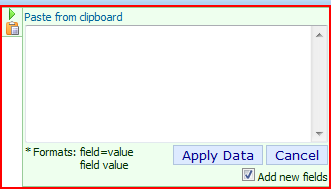
The paste area allows you to type or paste text from the clipboard.
Field names and their values can be delimited with a space, tab, or equal sign (e.g. Value 10K, Value=10K).
Once the fields have been specified, click the Apply button to assign the fields.
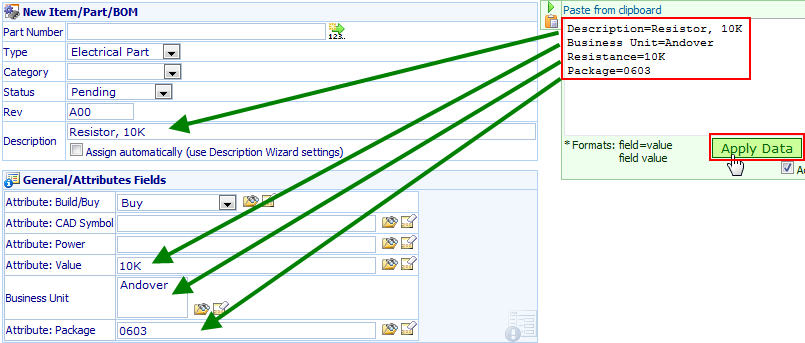
Your Omnify administrator or qualified Omnify Application Engineer can setup field name mappings.
Notice in the example the system has mapped the field called "Resistance" to the Omnify attribute "Value".
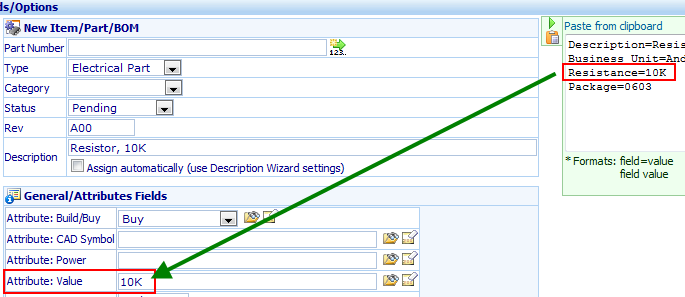
|
 |
New Object Creation |
Top |
|
Once all field values have been specified, click the Create button to create the object.

The system will present a verification message.
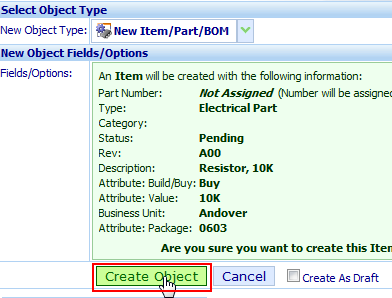
Click the Create Object button to create the object.
The system will redirect the user to the object form.
|
 |
Draft Items |
Top |
|
When creating new objects, you will have the option to create the object in "Draft" mode.

"Draft" objects are objects that have been created, however the signoff routing has not been started.
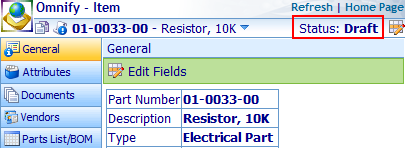
Draft items will remain in your Inbox until you begin the signoff process.
To begin the signoff process, select the Signoff tab and click the Start Routing hyperlink
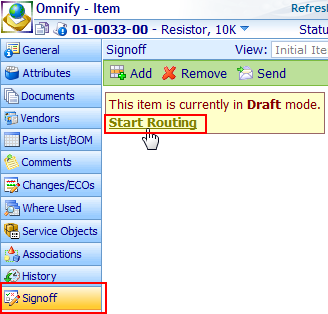
|
 |
Using New Like |
Top |
|
Omnify provides a "New Like" feature that allows you to copy data from any existing object.
The "New Like" can be launched from the Database Search form or from the object form banner.
To launch the "New Like" from the Database Search form, first check the object you wish to copy and then click the New Like toolbar button.

The New Like form will appear.
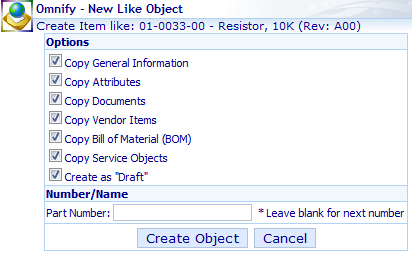
To launch the "New Like" from the object form banner, select the Create New Like link from the object banner action menu.
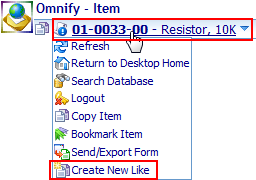
The New Like form will indicate the copied object and provide you with an option to select which data to copy.
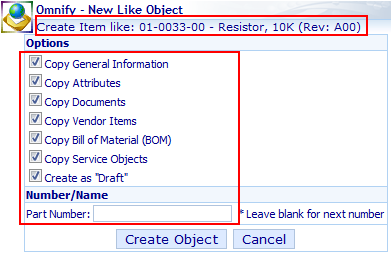
|